
HEIFER HAD A LITTLE FARM (October 2008)
Five bucks may not buy much these days. But if you put your mind to work, you may come up with an idea of how to use it to the fullest. Like putting several kids and babcia in your car, and driving to the nearest Heifer farm. Because that's how much it would cost you to enter (per car) its 260acres, and to be provided with an entire day's worth of entertainment for the whole bunch.
I spent last weekend there entertaining others. For a few years now, my family has been volunteering proudly representing Poland at Heifer's Global Village. We cover one event in June and the harvest festival in October.
For those unfamiliar with the project, Heifer's primary mission, when created, was to breed animals and distribute them all over the world in areas where livestock is most needed. These days, rather than being shipped, the animals are bought in the country to help the economy and save on transportation.
Until now, Poland was one of these places, although as a member of the EU, it's probably less and less dependent on Heifer. The headquarters of the Carpathian region are based in Warsaw. We can trace every Polish family in the Podkarpacie area that received a sheep or a goat.
When communism fell, the new government was preoccupied with the more or less important problems while many farmers had a hard time surviving the new reality. Heifer came to the rescue. Then when in the 90s, some farmers lost their animals due to floods, Heifer reached out to them as well.
The foundation's goals of "working with communities to end hunger and poverty and to care for the Earth" go beyond its boundaries. Poland is an example where the political situation plays no role. There will always be someone left out. The part that I like the most is that people do not just receive an animal, but they learn to share it (by giving away the firstborn) with others and the "gift of giving" continues…
It all started with Dan West, an American relief worker who distributed powdered milk to the children of Spain during the Spanish civil war when he realized that, "These children don't need a cup, they need a cow." To make a long story short, heifer cows were picked, because they were young and the families who received them were obligated to give a female offspring to another family in the village and so on.
Look through the pages of the online catalog and you will discover that, that for example, $150 buys you a llama, $20 will get you a share of it, or you may pay $30 for the gift of honeybees. Water buffalo may not be appreciated in Slovakia nor a camel in Romania, but it will make some, let's say Filipino family, very happy. And look at the benefits! It is used for power for planting rice and potatoes, for milk, its manure for fertilization but also for … fuel. And all it eats is the grass that is not "suitable for harvesting." How cool is that?!
The farm located in Rutland, MA, is an education site and is open to the public for a variety of events throughout the year. Locals from neighboring churches visit as well as busloads from as far as New York . Volunteers either live on the farm, like students from Texas or Mexico and some even from Poland) and others only come for the event, from states like Vermont or New Hampshire.
My own first encounter took place when a Heifer representative came to my local senior center with the slide show on Ukraine. Someone suggested that I set up a Polish display to introduce Poland alongside. And I'm glad that I came, because the slide show showed no distinction between Poland and Ukraine, so at first I just rolled my eyes, sighed, and then decided to put my foot in the door to see what I can do to improve understanding of other cultures (mainly the Polish culture).
It turned out that Heifer hosts an annual International Fair where countries like Ghana, Kenya, Guatemala, China, Chile, Mexico represent areas of the organization's posts. The United States is represented by Maine, and Poland covers Central and Eastern Europe.
I found out that the so-called Global Village was a camp-like setting of tents and clay huts spread out in the woods, and from whatever your site was, you could barely see another. On hot summer days your only access was through a dusty narrow road, which on rainy days, the path turned muddy. Child volunteers would help to bring your stuff to the site.
They used to carry it all in a wheelbarrow. Back then there was only one, so if you were late (once we were stuck on the main road, behind a cavalcade of motorcycles!), the wheelbarrow was already being used in…the animal parade.
Still, I was more than happy to become their "Polish liaison." I took over the tent with no floor but full of people constantly tripping over the tree roots. Typical were live chickens picking up the crumbs of my gingerbread cookies and vanilla fudge candy from Poland called "krowka" with a cow logo. On hot days, we served an apple mint drink from Poland or blackcurrant juice, both chilled. Student helpers made cutouts keeping the children busy, while I had a chance to chat with their parents and introduce them to Polish history and culture. A detailed map helped many find … small villages
from where their ancestors took their lifetime voyage. One man spent more than 20 min looking for one, and then started reading everything there was on the table until his wife showed up and grinding her teeth, she spat out, "your son is looking for you!" I gave out so much info that many think that I'm a travel agent!
My oversized framed picture of the Black Madonna once broke on the bumpy road, but that is what the duct tape is for. That portrait put a big smile on the faces of some African delegation who remembered John Paul's visit to their native country. I love seeing the great surprised looks on people's faces when they discover our Polish tent there…
Each site gets an animal. I always ask for something cute like a lamb or sheep to attract children. China or Tibet get yaks. Kenya gets goats. One year, when I chatted with a "Kenyan" milking a goat at the next site, I found out that he is one of those lead runners at the Boston marathon!! I have two marathon runners in my household so we know who those Kanyans are, and they are pretty famous in the Boston area. I just never expected seeing one milking goats. He traveled from Washington, D.C to volunteer for that weekend.
At the Global Village, the only time when the traffic slows down is when there is a horse show, and Dale Perkins is the mastermind behind it. His horses can actually jump through fire, but my personal favorite is watching a sheep dog chasing chicks or geese.
The place is an example of a well-organized small community. Everyone knows his place and job assignment. There are volunteers who take care of animals at the site and bring them water. Others make sure we take breaks, and whatever they serve for food is all grown on the farm. Once on a hot day, each of us got a yogurt that came with an environmental friendly spoon that looked like plastic, but was actually made of …sugar cane, so you could feel free to throw it on the ground afterwards.
I noticed that the female volunteers at my site often asked pregnant visitors about their due date, and this is not as if they like to use such line to start a conversation … the practical reason behind it is that they need a baby Jesus for their Live Nativity scene.
And each year they need a new one!
Quite intriguing crowd we have up there!
(My great source of information, one of the sites teaches how to use goat manure.)
And I have to tell you, from displaying the Polish flag upside down at the entrance, stocking up on Ukrainian (that passed as Polish) items, a potato stamp to… a real log cabin for us and our display … Heifer came a long way!
And as we learn from them over time (giving examples how to deal with earthy problems, their solutions and future goals), they too are learning something from us as well. Besides introducing the public to Heifer's work in Poland, we teach people about Polish culture, history, customs, and by revealing some interesting facts and contradictions, we are challenging stereotypes.
In my harvest basket, among other products, I display original 100% rye bread, horseradish, buckwheat, pickles in brine, carrot and blackcurrant juices, plum marmalade, but also unknown in the US, Polish beer or mead.
Poles are often known as meat and potato kind of people, so I have fun talking about fish and the variety of fish served on Polish tables. It makes sense having access to the Baltic sea (a chance to compare to our own …Cape Cod) and Mazury / The Land of Thousand Lakes (a chance to invite young visitors for kayaking, which is very popular in Poland). Smoked eel also makes a list…
When presenting Christmas, we concentrate on why it is so important to Polish Americans to share the same traditions. We explain it through Poland's tragic history, partitions, invasions, and occupation. How millions of Poles were dislocated all over the world. It is incredibly important for all of us to know that at the same time, all of us sit down and, pretty much, celebrate Christmas the same way - it's a bonding experience.
And here comes a chance to tell people that the fact that we still speak Polish is a miracle, because for previous generations, the language was forbidden and German or Russian was imposed upon us. It was up to the parents to teach their children their native language ... and so on.
Here I can talk about how the Italian Princess Bona married a Polish king and brought cabbage and cauliflower to Poland. Or I can give a whole new meaning to "kielbasa" when talking about its Hebrew origins (Kol Basar).
Stuff like this seems to be very amusing. 99% do not know much, a few know some, but do not know why, and if I could be the link between … the pleasure is all mine.
I call it an "adjustment" to the existing profile of Poles.
An oversized picture of "Lajkonik (a Turkish horseman entertaining tourists in the Krakow market square) gets attention and gives me a chance to talk about…invasions, King Jan III Sobieski, battle of Vienna, coffee beans, etc..
My approach is working as we are told over and over that our display was again, a huge hit.
Now, here comes the part that I do not understand. I asked several friends to either help or visit us there. For some unknown reason, they all prefer to go to … some Polish festival rather than help create this site and introduce their heritage. This mentality ought to change if we want to survive (as a group) amongst others.
I know that Pulaski Day Parade is huge. We've been to a couple, and it attracts tens of thousands of Polish Americans, but I would rather cover Heifer because … nobody else will. The Pulaski Day Parade gets a lot of attention in the Polish-American press, and the crowd grows each year, with or without our help.
I get a kick from the fact that at Heifer, those who visit have no clue that in the middle of the forest there will be a Polish log house, and someone will give them a short tour of Poland. Some come through and leave in a rush, others linger on in amazement.
Heifer turns out to be a place where I can correct misunderstandings, where
people can ask, and sometimes get a quite surprising answer.
Once at dinner at a friend's house, a couple of young Polish professionals laughed at me and the idea of a Polish display. I guess they were too cool to ever set foot on a farm. Oh well…you can complain about Poles being misrepresented or you can do something about it and make the existing image look more attractive. There are others who strictly participate only in Polish festivals. And to tell you the truth, those events have very little in common with Polish culture (unless you consider a "Polish platter" of kielbasa, boiled pierogi with lamp of butter and slice of rye bread a "culture.").
What festivals do (besides giving many that warm feeling of belonging to certain ethnic group) at the same time, they separate Poles from the larger community. I never see Polish groups amongst other ethnic groups at multicultural events. The Pulaski Day Parade is great, but the Columbus Day Parade in Worcester, Mass until now did not have Polish representation. And now we march with Italian-Americans and Scottish pipers. Twice, we were invited to join the St Patrick's parade (a huge event in Worcester), but many of us won't participate because of …the cold. Something tells me that if we don't do it next year, the St Patrick's Committee won't bother us again...
Now, it wouldn't be me if I didn't bring out some fact from my childhood that is somehow connected to the Heifer Project. You want to bet that I have one?
Heifer's work in Poland began shortly after WWII when livestock was almost nonexistent due to the fact that either starving people consumed it or occupying armies confiscated it. Before Heifer in Poland, there was the UNRRA (United Nations Relief and Rehabilitation Administration). UNRRA was already shipping goods to Europe and supplied boats while Heifer donated horses and paid the men who delivered them.
In the UNRRA files, there is a picture of the "poor Polish children of Oswiecim (German name: Auschwitz) awaiting distribution of soap." Now, at my grandma's, my cousin and I often played outside in those huge wooden boxes with the UNRRA logo on them. We collected pine cones in white UNRRA bags that were previously used to distribute flour.
My uncle, who was 6 when the war ended, told me that his family received UNRRA's aid packages "for the children." Among other goodies, there was: bacon, powdered milk, puddings packed in small green containers as if for the army, orange marmalade (very sweet!), juices in large 2 liter cans, chewy candy, beans in tomato sauce, (very) blood (y) sausage, margarine and chocolate. There was also clothing, army boots, sweaters, underwear, sheepskin pilot jacket that my uncle wore even years later as a student at UW (Warsaw University), as well as soap and DDT … for bedbugs and head lice which was crucial! UNRRA packaged those goodies in cardboard boxes that were shipped in those huge wooden crates that years later we used for our plays.
As he put it: "Maybe it's because of those packages that we all grew up to be healthy despite having a tragic childhood."
Heifer picked up where UNRRA left off in 1947.
After two days, my harvest basket was plucked clean and Jacek could finally have his (Polish) beer…
He did not know yet that in a week, at the Columbus Day Parade, he will be asked to carry a speaker that played terrible polka music that for some reason intertwined with La Cucaracha song.
Five bucks may not buy much these days. But if you put your mind to work, you may come up with an idea of how to use it to the fullest. Like putting several kids and babcia in your car, and driving to the nearest Heifer farm. Because that's how much it would cost you to enter (per car) its 260acres, and to be provided with an entire day's worth of entertainment for the whole bunch.
I spent last weekend there entertaining others. For a few years now, my family has been volunteering proudly representing Poland at Heifer's Global Village. We cover one event in June and the harvest festival in October.
For those unfamiliar with the project, Heifer's primary mission, when created, was to breed animals and distribute them all over the world in areas where livestock is most needed. These days, rather than being shipped, the animals are bought in the country to help the economy and save on transportation.
Until now, Poland was one of these places, although as a member of the EU, it's probably less and less dependent on Heifer. The headquarters of the Carpathian region are based in Warsaw. We can trace every Polish family in the Podkarpacie area that received a sheep or a goat.
When communism fell, the new government was preoccupied with the more or less important problems while many farmers had a hard time surviving the new reality. Heifer came to the rescue. Then when in the 90s, some farmers lost their animals due to floods, Heifer reached out to them as well.
The foundation's goals of "working with communities to end hunger and poverty and to care for the Earth" go beyond its boundaries. Poland is an example where the political situation plays no role. There will always be someone left out. The part that I like the most is that people do not just receive an animal, but they learn to share it (by giving away the firstborn) with others and the "gift of giving" continues…
It all started with Dan West, an American relief worker who distributed powdered milk to the children of Spain during the Spanish civil war when he realized that, "These children don't need a cup, they need a cow." To make a long story short, heifer cows were picked, because they were young and the families who received them were obligated to give a female offspring to another family in the village and so on.
Look through the pages of the online catalog and you will discover that, that for example, $150 buys you a llama, $20 will get you a share of it, or you may pay $30 for the gift of honeybees. Water buffalo may not be appreciated in Slovakia nor a camel in Romania, but it will make some, let's say Filipino family, very happy. And look at the benefits! It is used for power for planting rice and potatoes, for milk, its manure for fertilization but also for … fuel. And all it eats is the grass that is not "suitable for harvesting." How cool is that?!
The farm located in Rutland, MA, is an education site and is open to the public for a variety of events throughout the year. Locals from neighboring churches visit as well as busloads from as far as New York . Volunteers either live on the farm, like students from Texas or Mexico and some even from Poland) and others only come for the event, from states like Vermont or New Hampshire.
My own first encounter took place when a Heifer representative came to my local senior center with the slide show on Ukraine. Someone suggested that I set up a Polish display to introduce Poland alongside. And I'm glad that I came, because the slide show showed no distinction between Poland and Ukraine, so at first I just rolled my eyes, sighed, and then decided to put my foot in the door to see what I can do to improve understanding of other cultures (mainly the Polish culture).
It turned out that Heifer hosts an annual International Fair where countries like Ghana, Kenya, Guatemala, China, Chile, Mexico represent areas of the organization's posts. The United States is represented by Maine, and Poland covers Central and Eastern Europe.
I found out that the so-called Global Village was a camp-like setting of tents and clay huts spread out in the woods, and from whatever your site was, you could barely see another. On hot summer days your only access was through a dusty narrow road, which on rainy days, the path turned muddy. Child volunteers would help to bring your stuff to the site.
They used to carry it all in a wheelbarrow. Back then there was only one, so if you were late (once we were stuck on the main road, behind a cavalcade of motorcycles!), the wheelbarrow was already being used in…the animal parade.
Still, I was more than happy to become their "Polish liaison." I took over the tent with no floor but full of people constantly tripping over the tree roots. Typical were live chickens picking up the crumbs of my gingerbread cookies and vanilla fudge candy from Poland called "krowka" with a cow logo. On hot days, we served an apple mint drink from Poland or blackcurrant juice, both chilled. Student helpers made cutouts keeping the children busy, while I had a chance to chat with their parents and introduce them to Polish history and culture. A detailed map helped many find … small villages
from where their ancestors took their lifetime voyage. One man spent more than 20 min looking for one, and then started reading everything there was on the table until his wife showed up and grinding her teeth, she spat out, "your son is looking for you!" I gave out so much info that many think that I'm a travel agent!
My oversized framed picture of the Black Madonna once broke on the bumpy road, but that is what the duct tape is for. That portrait put a big smile on the faces of some African delegation who remembered John Paul's visit to their native country. I love seeing the great surprised looks on people's faces when they discover our Polish tent there…
Each site gets an animal. I always ask for something cute like a lamb or sheep to attract children. China or Tibet get yaks. Kenya gets goats. One year, when I chatted with a "Kenyan" milking a goat at the next site, I found out that he is one of those lead runners at the Boston marathon!! I have two marathon runners in my household so we know who those Kanyans are, and they are pretty famous in the Boston area. I just never expected seeing one milking goats. He traveled from Washington, D.C to volunteer for that weekend.
At the Global Village, the only time when the traffic slows down is when there is a horse show, and Dale Perkins is the mastermind behind it. His horses can actually jump through fire, but my personal favorite is watching a sheep dog chasing chicks or geese.
The place is an example of a well-organized small community. Everyone knows his place and job assignment. There are volunteers who take care of animals at the site and bring them water. Others make sure we take breaks, and whatever they serve for food is all grown on the farm. Once on a hot day, each of us got a yogurt that came with an environmental friendly spoon that looked like plastic, but was actually made of …sugar cane, so you could feel free to throw it on the ground afterwards.
I noticed that the female volunteers at my site often asked pregnant visitors about their due date, and this is not as if they like to use such line to start a conversation … the practical reason behind it is that they need a baby Jesus for their Live Nativity scene.
And each year they need a new one!
Quite intriguing crowd we have up there!
(My great source of information, one of the sites teaches how to use goat manure.)
And I have to tell you, from displaying the Polish flag upside down at the entrance, stocking up on Ukrainian (that passed as Polish) items, a potato stamp to… a real log cabin for us and our display … Heifer came a long way!
And as we learn from them over time (giving examples how to deal with earthy problems, their solutions and future goals), they too are learning something from us as well. Besides introducing the public to Heifer's work in Poland, we teach people about Polish culture, history, customs, and by revealing some interesting facts and contradictions, we are challenging stereotypes.
In my harvest basket, among other products, I display original 100% rye bread, horseradish, buckwheat, pickles in brine, carrot and blackcurrant juices, plum marmalade, but also unknown in the US, Polish beer or mead.
Poles are often known as meat and potato kind of people, so I have fun talking about fish and the variety of fish served on Polish tables. It makes sense having access to the Baltic sea (a chance to compare to our own …Cape Cod) and Mazury / The Land of Thousand Lakes (a chance to invite young visitors for kayaking, which is very popular in Poland). Smoked eel also makes a list…
When presenting Christmas, we concentrate on why it is so important to Polish Americans to share the same traditions. We explain it through Poland's tragic history, partitions, invasions, and occupation. How millions of Poles were dislocated all over the world. It is incredibly important for all of us to know that at the same time, all of us sit down and, pretty much, celebrate Christmas the same way - it's a bonding experience.
And here comes a chance to tell people that the fact that we still speak Polish is a miracle, because for previous generations, the language was forbidden and German or Russian was imposed upon us. It was up to the parents to teach their children their native language ... and so on.
Here I can talk about how the Italian Princess Bona married a Polish king and brought cabbage and cauliflower to Poland. Or I can give a whole new meaning to "kielbasa" when talking about its Hebrew origins (Kol Basar).
Stuff like this seems to be very amusing. 99% do not know much, a few know some, but do not know why, and if I could be the link between … the pleasure is all mine.
I call it an "adjustment" to the existing profile of Poles.
An oversized picture of "Lajkonik (a Turkish horseman entertaining tourists in the Krakow market square) gets attention and gives me a chance to talk about…invasions, King Jan III Sobieski, battle of Vienna, coffee beans, etc..
My approach is working as we are told over and over that our display was again, a huge hit.
Now, here comes the part that I do not understand. I asked several friends to either help or visit us there. For some unknown reason, they all prefer to go to … some Polish festival rather than help create this site and introduce their heritage. This mentality ought to change if we want to survive (as a group) amongst others.
I know that Pulaski Day Parade is huge. We've been to a couple, and it attracts tens of thousands of Polish Americans, but I would rather cover Heifer because … nobody else will. The Pulaski Day Parade gets a lot of attention in the Polish-American press, and the crowd grows each year, with or without our help.
I get a kick from the fact that at Heifer, those who visit have no clue that in the middle of the forest there will be a Polish log house, and someone will give them a short tour of Poland. Some come through and leave in a rush, others linger on in amazement.
Heifer turns out to be a place where I can correct misunderstandings, where
people can ask, and sometimes get a quite surprising answer.
Once at dinner at a friend's house, a couple of young Polish professionals laughed at me and the idea of a Polish display. I guess they were too cool to ever set foot on a farm. Oh well…you can complain about Poles being misrepresented or you can do something about it and make the existing image look more attractive. There are others who strictly participate only in Polish festivals. And to tell you the truth, those events have very little in common with Polish culture (unless you consider a "Polish platter" of kielbasa, boiled pierogi with lamp of butter and slice of rye bread a "culture.").
What festivals do (besides giving many that warm feeling of belonging to certain ethnic group) at the same time, they separate Poles from the larger community. I never see Polish groups amongst other ethnic groups at multicultural events. The Pulaski Day Parade is great, but the Columbus Day Parade in Worcester, Mass until now did not have Polish representation. And now we march with Italian-Americans and Scottish pipers. Twice, we were invited to join the St Patrick's parade (a huge event in Worcester), but many of us won't participate because of …the cold. Something tells me that if we don't do it next year, the St Patrick's Committee won't bother us again...
Now, it wouldn't be me if I didn't bring out some fact from my childhood that is somehow connected to the Heifer Project. You want to bet that I have one?
Heifer's work in Poland began shortly after WWII when livestock was almost nonexistent due to the fact that either starving people consumed it or occupying armies confiscated it. Before Heifer in Poland, there was the UNRRA (United Nations Relief and Rehabilitation Administration). UNRRA was already shipping goods to Europe and supplied boats while Heifer donated horses and paid the men who delivered them.
In the UNRRA files, there is a picture of the "poor Polish children of Oswiecim (German name: Auschwitz) awaiting distribution of soap." Now, at my grandma's, my cousin and I often played outside in those huge wooden boxes with the UNRRA logo on them. We collected pine cones in white UNRRA bags that were previously used to distribute flour.
My uncle, who was 6 when the war ended, told me that his family received UNRRA's aid packages "for the children." Among other goodies, there was: bacon, powdered milk, puddings packed in small green containers as if for the army, orange marmalade (very sweet!), juices in large 2 liter cans, chewy candy, beans in tomato sauce, (very) blood (y) sausage, margarine and chocolate. There was also clothing, army boots, sweaters, underwear, sheepskin pilot jacket that my uncle wore even years later as a student at UW (Warsaw University), as well as soap and DDT … for bedbugs and head lice which was crucial! UNRRA packaged those goodies in cardboard boxes that were shipped in those huge wooden crates that years later we used for our plays.
As he put it: "Maybe it's because of those packages that we all grew up to be healthy despite having a tragic childhood."
Heifer picked up where UNRRA left off in 1947.
After two days, my harvest basket was plucked clean and Jacek could finally have his (Polish) beer…
He did not know yet that in a week, at the Columbus Day Parade, he will be asked to carry a speaker that played terrible polka music that for some reason intertwined with La Cucaracha song.




















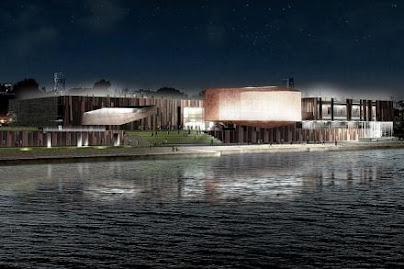











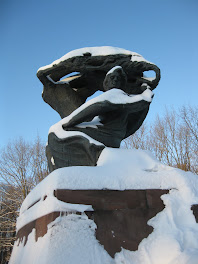
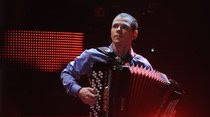


































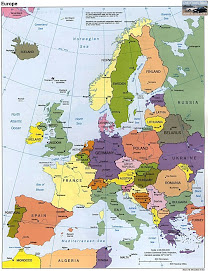


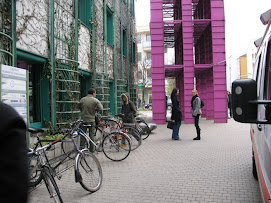
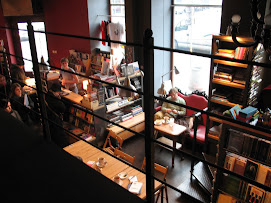
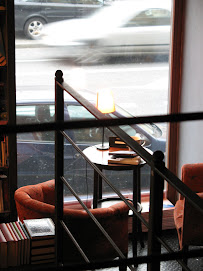



















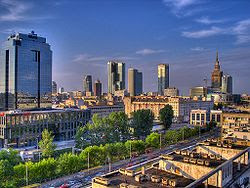




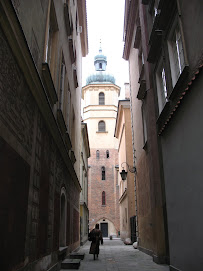












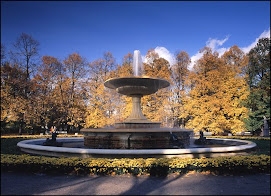








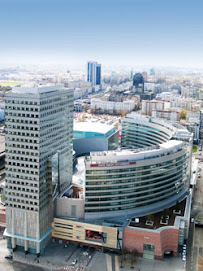.jpg)










No comments:
Post a Comment